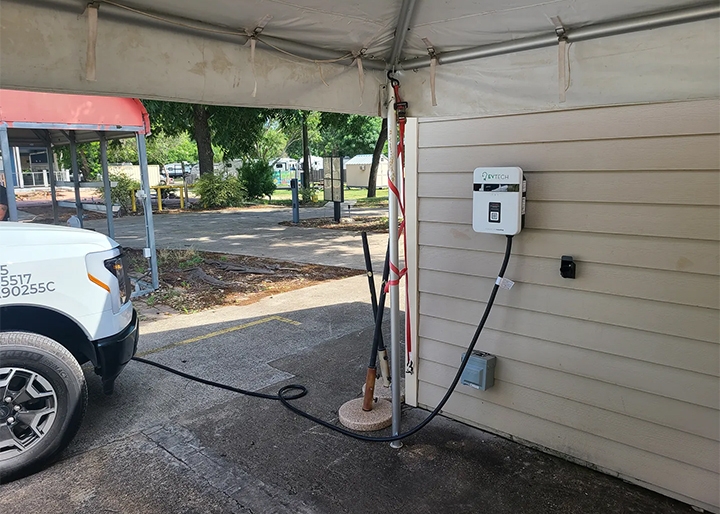
Government Initiatives & Rising EV Demand
Recent domestic and foreign government initiatives to drive EV adoption and demand for convenient, faster charging options are key factors driving the growth of the global energy infrastructure for EV charging stations. However, the high cost of infrastructure equipment is expected to restrain the growth of the global energy infrastructure for EV charging stations. The impact of existing infrastructure on electrical vehicle charging stations also presents challenges to the growth of the market.
The inclusion of EV infrastructure investment into COVID-19-related stimulus packages by governments of countries in Europe and Asia is expected to boost its growth in the future. For instance, in June 2020, Germany proposed a €130 billion ($145.8 billion) stimulus future package, featuring at least €50 billion ($56 billion) for climate-related spending. It includes plans to boost EV sales, improve building energy efficiency, enhance public transport networks, develop hydrogen infrastructure, and shift the cost of renewables subsidies onto general taxation. Subsidies for EVs were also doubled. The program includes an extra €2.5 billion ($2.8 billion) for EV infrastructure, including EV charging stations.
However, most governments from affected regions have turned to infrastructure rehabilitation to stimulate economic recovery. Several governments are investing in charging infrastructure through direct investments for public charging stations or subsidies for installing private charging stations at homes and workplaces. For instance, in April 2020, China announced subsidies amounting to $1.4 billion for installing charging stations. In Germany, the government announced a stimulus package worth €2.5 billion to develop infrastructure for EVs and construct charging stations. The European Union aims to have one million charging stations by 2025. In addition, in January 2021, the Government of India allocated $486 million as incentives for adopting 7,090 e-buses. Such initiatives by the governments are anticipated to drive the growth of the EV market, creating growth prospects for the energy infrastructure for the EV charging stations market.
The global energy infrastructure for EV charging stations market is segmented based on component (transformers, electric distribution systems, heavy-duty cables, metering systems, power converters, energy storage systems, and solar PV panels), number of EVSE (less than 5 units, 5 to 15 units, and more than 15 units), energy source (renewable energy sources, and non-renewable energy sources), and geography. The study also evaluates industry competitors and analyses the market at the country and regional levels.
Based on component, the global energy infrastructure for the EV charging stations market is segmented into transformers, electric distribution systems, heavy-duty cables, metering systems, power converters, energy storage systems, and solar PV panels. In 2022, the transformers segment is estimated to account for the largest share of the global energy infrastructure for the EV charging stations market. The growth of this segment is attributed to its wide usage for powering EV charging applications and helps maintain the power as per charging stations’ requirements. However, the energy storage systems segment is estimated to grow at the highest CAGR during the forecast period due to various initiatives by OEMs and stakeholders, which help develop ESS for EV charging stations.
Based on number of EVSE, the global energy infrastructure for EV charging stations market is segmented into less than 5 units, 5 to 15 units, and more than 15 units. In 2022, the less than 5 units segment is estimated to account for the largest share of the global energy infrastructure for the EV charging stations market. The growth of this market is driven by increasing investments by retail space owners & managers and fuel station owners to include EV charging in their premises. However, the 5 to 15 units segment is expected to grow at the highest CAGR during the forecast period due to various government incentives, tax credits, and reimbursements for the commercial installation of charging stations.
Based on energy source, the global energy infrastructure for the EV charging stations market is segmented into renewable energy sources and non-renewable energy sources. In 2022, the non-renewable energy sources segment is estimated to account for the larger share of the global energy infrastructure for the EV charging stations market. The growth of this segment is attributed to government incentives and subsidies for purchasing EVs and EV charging infrastructure.
Based on geography, the energy infrastructure for EV charging stations market is segmented into North America, Europe, Asia-Pacific, Latin America, and the Middle East & Africa. In 2022, Asia-Pacific is estimated to account for the largest share of the global energy infrastructure for the EV charging stations market. The growth of this segment is attributed to the growing demand for EVs in countries such as China and Japan and rising government initiatives to reduce greenhouse gas emissions, which, in turn, is poised to increase the adoption of EVs. However, Europe is expected to grow at the highest CAGR during the forecast period. The growth in this market is driven by government initiatives to develop charging infrastructure across the region. France, Germany, Netherlands, Norway, and the U.K. are five front-runner countries for EVs and charging points across the region.




